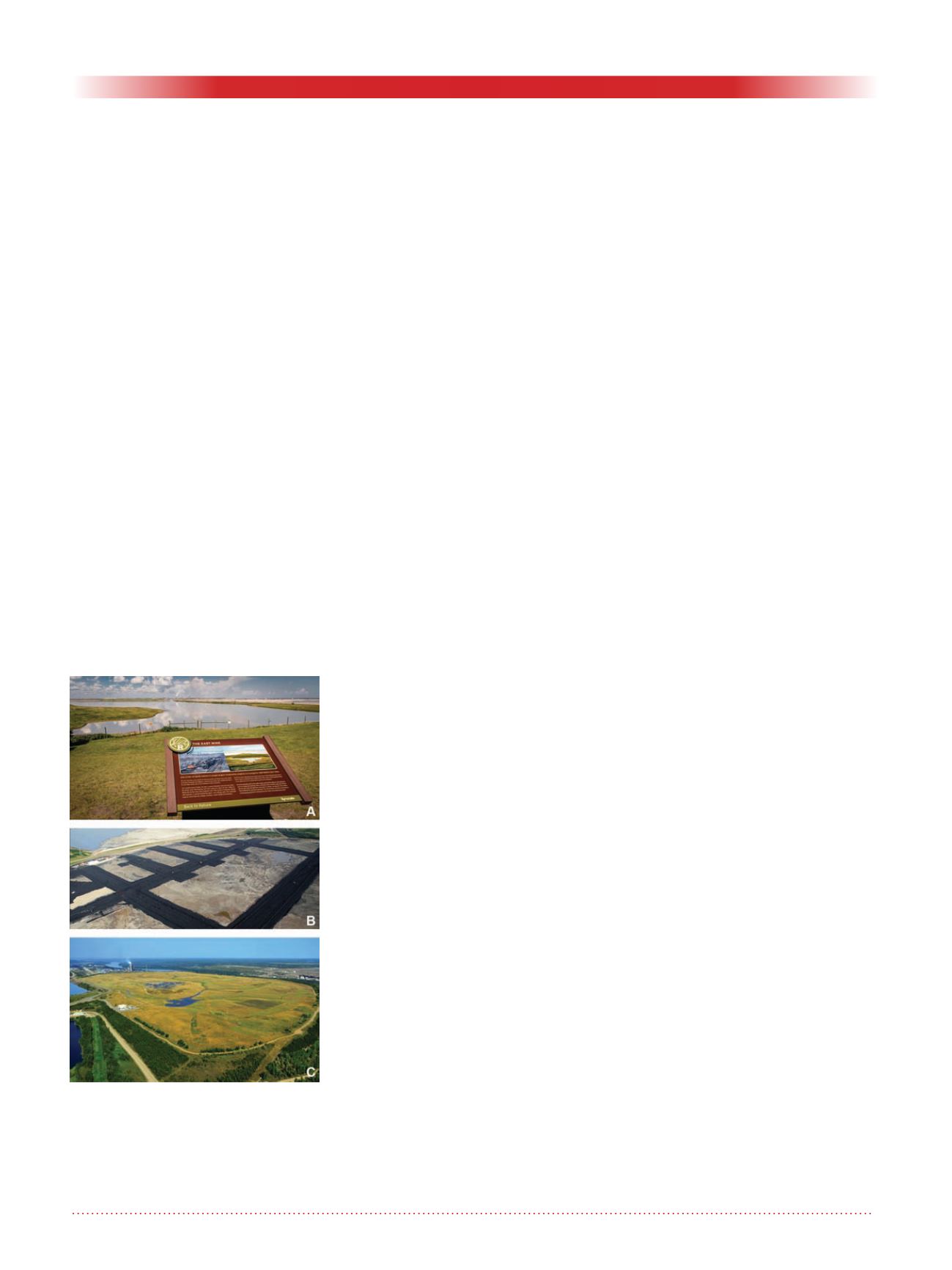
34
Geotechnical News • June 2017
WASTE GEOTECHNICS
uplands, wetlands, and lakes). Mines
declare specific reclamation objectives
and design criteria to support this and
other goals (eg Ansah-Sam et al 2016).
To build useful post-mining land-
scapes, designers need to ensure
that each soft tailings deposit can be
reclaimed to safely support uplands,
wetlands, and lakes and that provide
sufficient water quantity and quality to
support downstream needs. Excessive
post-reclamation settlement can lead
to enlargement of lakes and wetlands,
upsetting the water balance, affecting
water quality, and changing the land
use mix. Figure 3 shows some recent
examples of oil sands soft tailings rec-
lamation projects designed to accom-
modate settlement.
The strength and density of oil
sands tailings
Figure 4 shows the relationship
between density and shear strength of
oil sands tailings using publicly avail-
able data. As might be expected, the
shear strength increases exponentially
with density. For comparison, the light
purple lines show the relationship
between liquidity index for natural
sensitive clays (as explored in the
1960s by Houston and Mitchell) with
similar Atterberg limits to oil sands
fine tailings: liquid limit=60%; plastic
limit=20%.
Most of oil sands soft tailings R&D
and commercial operations are
focused on increasing densities and
strengths through chemical and
mechanical treatment. Much of the
variation in the strengths in Figure 4 is
due to the impact of chemical amend-
ments – typically coagulants and
flocculants. Some scatter is due to the
wide range of clay contents.
The six-pack of soft tailings cap-
ping methods
Figures 5 and 6 present six ways that
soft tailings are capped:
• A water cap
can be used to reclaim
tailings to a lake. As tailings are
pumped to a newly mined out
pit, the shorelines and outlet are
constructed, then water is pumped
in to flood the deposit. The initial
water cap is designed to be deep
enough to prevent lake currents
from resuspending the tailings at
the mudline and help kickstart a
productive ecosystem (see CEMA
2012). Syncrude’s Base Mine Lake
is a full-scale prototype water-
capped tailings end pit lake (see
Figure 3A).
• A low-density
floating cap
can be
employed where the underlying
tailings are denser than the cap.
Suncor has successfully capped
fluid tailings using its low-density
petroleum coke (similar to coal)
placed by small equipment onto
a reinforced geofabric rolled out
on a frost layer in the winter (see
Figure 3B).
• Raining-in
tailings sand in thin
lifts over soft tailings is an option
where the tailings are a little stron-
ger and denser. Floating barges,
connected with winches and cables
to the shore or guided by dynamic
position systems, lay out very thin
(sometimes less than 5 cm) lifts of
sand by spraying the sand slurry
through the water column, to allow
it to gently come to rest on the
mudline. A common technique
for capping natural harbour, lake,
and river sediments, raining-in has
been piloted in the oil sands on
low-density untreated tailings. Un-
like natural sediments, untreated
oil sands tailings does not con-
solidate between these lift place-
ments, and hence does not increase
in density or strength. Mixing or
inversion (where the denser cap
plunges to the base of the soft tail-
ings) are risks. Treated oil sands
tailings are likely more amenable
to the raining-in technique.
• Hydraulic beaching
of tailings sand
is used where the soft tailings de-
posit is stronger and denser. A cap
is placed hydraulically from the
dyke using open-pipe discharge
(or with spigots or a discharge
spoon) forming a thick layer
over the underlying soft tailings.
Beaching has been successful at
commercial scale on several soft
deposits that have similar or higher
density to that of the capping
layer (see Figure 3C). Beaching
has been unsuccessful where the
capping slurry is denser than the
soft tailings – the capping material
reports to the bottom of the deposit
(known elsewhere as the
displace-
ment technique
).
• Soft-ground techniques
involving
mechanical placement of mine
waste or tailings sand with small
earthworks equipment and geogrid
can be employed where shear
strengths are greater than 25 kPa
(see Figure 2). Small dozers and
25 to 40 T trucks are carefully
employed to place fill, often in
1 m lifts. Trucks are kept away
from the face – they dump, then
the dozer pushes the fill over the
crest, onto the geogrid. For mod-
erately dense soft tailings, soft-
Figure 3. Oil sands soft tailings rec-
lamation. A: water-capped tailings
at Syncrude; B: Floating coke-
capped tailings at Suncor;
C: Hydraulic beach capped tailings
at Suncor.


